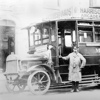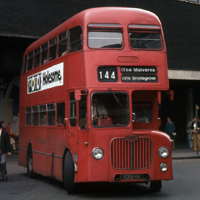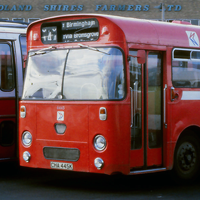Service 144: Service History
Page Content
Introduction
Service 144
Route number 144 was not introduced until Saturday 11th February 1928, but the origins of Service 144 can be traced as far back as Saturday 7th June 1913 when the Worcester Electric Traction Company Limited started operating daily motor omnibuses between Droitwich Spa and Worcester, with certain journeys continuing to Great Malvern (Beauchamp Hotel). This service proved to be very popular and on Monday 27th October 1913 the route was extended to Bromsgrove, then on Saturday 20th December 1913 to Rubery with a connecting bus operated by Birmingham Corporation to Selly Oak where there was a tram link to Birmingham City Centre.
On Saturday 15th August 1914 the Worcester Motor Transport Company Limited took over the bus routes of the Worcester Electric Traction Company Limited, following the merger and reorganisation of a number of companies in the Worcester and Kidderminster area. Two weeks later on Saturday 29th August 1914, the service was again extended to run all the way to Birmingham City Centre, thus removing the need to change at Rubery and Selly Oak. From this time it was operated by both the Worcester Motor Transport Company Limited and Birmingham and Midland Motor Omnibus Company Limited (BMMO—Midland “Red” Motor Services) as a joint operation, running as BMMO Service 25. Timetables advertised this as a “through service” but in practice, passengers were required to change buses in Bromsgrove.
Great Britain entered the First World War on Tuesday 4th August 1914, and soon after the entire fleet operated by Worcester Motor Transport Company Limited (except for a few spare bus bodies) were commandeered by the War Office for use as troop transport vehicles. This started in September 1914 and this company were soon unable to operate, so from Wednesday 4th November 1914 BMMO took over all their operations, including the full route of Service 25, short-working journeys between Worcester and Great Malvern as Service 36, along with other routes in the Worcester and Kidderminster area.
Now under the full operation of BMMO, a new Service 25 timetable was introduced from Saturday 7th November 1914 that removed the need for the passenger to change buses in Bromsgrove and thus giving the first direct bus service between Great Malvern, Worcester, Droitwich, Bromsgrove and Birmingham. The additional vehicles required were housed at two sites in Worcester, both being owned by Worcester Motor Transport Company Limited, with vehicles operating from the Birmingham end being housed at BMMO's Bearwood depot.
By May 1915 a bus company operating local routes in Malvern, W. & B. Woodyatt Limited, had also lost a number of vehicles to the war effort and were struggling to meet demand, operating all their routes with just one vehicle to a much reduced timetable. BMMO had noticed this and on Thursday 23rd March 1916 the BMMO Traffic Manager, Mr OC Power, wrote to the Licensing Committee to apply to extend Service 25 to Malvern Wells. He offered a direct hourly service to Birmingham and pointed out numerous advantages this would bring to Malvern in general, and also offered to take over all the Woodyatts local services in Malvern at the same time. Woodyatts agreed to give up their operations and BMMO started running local services in Malvern on Saturday 22nd April 1916, with Service 25 being extended to run to Malvern Wells from the same date. However, within six weeks the company was forced to reduce the number of journeys operated due to war-time shortages.
In 1917, the Ministry of Munitions warned all bus companies that they should abandon all services that were not of national importance, so because of this and general fuel restrictions, the service was shortened to run only between Worcester and Malvern Wells. Eight vehicles per day were used, and all were converted to run on coal gas.
Normal services resumed after the war ended and the service frequency was increased to run every 45-minutes, with certain days seeing a frequency of every 30-minutes during the summer. On Monday 26th July 1920, a new depot was opened in Bromsgrove providing extra capacity on the route, and this was followed in April 1921, when one of the two Worcester Motor Transport sites used to house buses in Worcester passed to BMMO.
On Saturday 16th May 1925 Service 25 was renumbered to Service 125 in an effort to give more numbering room in BMMO's rapidly expanding network, but this number was short-lived and the route soon became known as Service 144.
For details of early local motor omnibus operations in the Malvern area, see Service 48.
Service 144 (1928–1974)
Operated by Birmingham and Midland Motor Omnibus Company Limited
On Saturday 11th February 1928 the Birmingham and Midland Motor Omnibus Company Limited (BMMO—Midland “Red” Motor Services) renumbered their entire network and at this time the Birmingham to Malvern Wells Service 125 was renumbered to Service 144. Buses operated every 45-minutes in each direction throughout the week, but additional journeys were added on certain days when extra demand was expected.
In the New Year of 1929, BMMO announced they were to scrap all their double-deck buses and services would be operated with what the company called “luxury coach-buses”, which they claimed are “most comfortable and capable of doing 40 m.p.h. on a clear road”. Thus saw the withdrawal of the petrol-electric open-top Tilling-Steven FS class of vehicle from the route (and within a year from the whole company) and the introduction of much more modern single-deck buses designed and built by BMMO. With the new, faster vehicles in service, BMMO cut the running time from Birmingham to Malvern Wells on Saturday 12th January 1929 by an impressive 34 minutes, to just 2 hours and 20 minutes. January 1929 also saw the opening of a new depot in Birmingham, and from this time the new Birmingham (Digbeth) depot operated buses from the Birmingham end of the route.
Until January 1930, all local BMMO operations in Malvern had been run by Worcester depot, but from this time the company leased a small garage in Portland Road, Malvern, from W. & B. Woodyatt Limited, having taken over their coach tour operations the previous year. The garage was operated as an outstation or “dormy garage” of Worcester depot and provided vehicles for use on Service 144 from the Malvern end, but this site was not suitable for double-deck vehicles so once the type was re-introduced on the route Malvern “dormy garage” only operated certain morning short-workings with single-deck buses. A full Malvern depot opened on Friday 10th September 1954 and from that time always provide three double-deck vehicles for the route until it closed.
In the early 1930s, buses ran every 45-minutes in each direction during the week and on Sunday mornings, with additional buses on Sunday evenings to provide a 30-minute frequency. On Saturdays buses ran every 30-minutes in the mornings, and every 20-minutes during the afternoons and evenings.
BMMO's idea of running their entire fleet with single-deck vehicles didn't last long and from 1932 the company started to build their own design of double-deck vehicles, the SOS“DD(RE)”, followed by the SOS “DD(FE)” from 1934. The introduction of more modern vehicles on Service 144 resulted in growing demand for the service and frequency was increased to run every 30-minutes in each direction during the week, then later to every 20-minutes, Sundays to Fridays, with extra buses on Saturdays to bring the frequency to every 15-minutes. This timetable remained virtually unchanged until the mid-1960s.
Before the Second World War, an inspector would be based to the Malvern Wells terminus to oversee the unloading and loading of passengers and ensure vehicles departed on time. At busy times the inspector would be required to telephone local garages to send duplicate vehicles, and under such circumstances, it was sometimes possible to see a bus from Hereford depot depot operating a Service 144.
Service 144 continued to run during the Second World War, but on Saturday 7th October 1939, local Malvern Service M22 which ran between Great Malvern, Belmont, and Malvern Link was withdrawn due to wartime fuel rationing so from this date certain journeys on Service 144 were diverted to run via Belmont as a replacement. Service M22 was reinstated with a much-reduced timetable on Monday 11th December 1939 allowing some, but not all, Service 144 journeys to return to the normal route. There were further timetable changes on Saturday 1st June 1940, on Saturday 13th July 1940, and again on Saturday 28th September 1940.
In the 1960s, with the rapid growth in private car ownership, roads were upgraded to cope with the increased traffic levels. Between Powick and Malvern Link the original twisty road was replaced with a much wider and direct road allowing vehicles to run more quickly. Parts of the old road can still be seen in places, such as Newland and outside the Halfway House Inn. A similar road layout change was near Lickey End where the road was upgraded to become a dual-carriageway and rerouted to connect with the new M5 motorway, which opened in July 1962. Other than changes imposed by new road layouts, the route of Service 144 remained unchanged throughout it's history. However, a Bank Holiday variation to Service 144 was introduced following the opening of the M5 motorway that ran as Service 188 using the new motorway to provide a direct link between Birmingham and The Malverns for day-trippers. This was in addition to the daily hourly Service X44 that provided a directly link between Birmingham and Worcester via the M5 motorway.
Route Summary
- Mar 1928–Mar 1974
- Birmingham
- Rubery
- Bromsgrove
- Wychbold
- Droitwich Spa
- Fernhill Heath
- Worcester
- Powick
- Malvern Link
- Great Malvern
- Malvern Wells
| 1 | 4 | 4 |
Timetable Archive
| December | 1930 | Birmingham ↔ Bromsgrove ↔ Worcester ↔ Malvern Wells | |
| March | 1932 | Birmingham ↔ Bromsgrove ↔ Worcester ↔ Malvern Wells | |
| April | 1933 | Birmingham ↔ Bromsgrove ↔ Worcester ↔ Malvern Wells | |
| June | 1940 | Birmingham ↔ Bromsgrove ↔ Worcester ↔ Malvern Wells | |
| June | 1957 | Birmingham ↔ Bromsgrove ↔ Worcester ↔ Malvern Wells | |
| March | 1972 | Birmingham ↔ Bromsgrove ↔ Worcester ↔ Malvern Wells |
Service 144 (1974–1981)
Operated by Midland Red Omnibus Company Limited
On Monday 3rd December 1973, Birmingham and Midland Motor Omnibus Company Limited (BMMO—Midland “Red” Motor Services) sold a number of depots and their operations to the West Midlands Passenger Transport Executive (WMPTE). As a result of this, the company renamed to Midland Red Omnibus Company Limited (MROC) on Friday 29th March 1974.
The Service 144 route followed what is today the A38 from Birmingham to Worcester and then the A449 through Malvern to Malvern Wells. The only major change came on Friday 1st October 1976 when National Bus Company cutbacks saw the closure of Malvern depot. With that came an entirely new network of services in and around Malvern, operated by Worcester depot, and the Worcester to Malvern Wells section of Service 144 was abandoned.
The closure of Malvern depot and the withdrawal of the Worcester to Malvern Wells section of the route also saw Service 144 finally converted to one-man operation starting on Saturday 2nd October 1976. The route was one of the last to be converted by Midland Red and had remained as crew operation because of the difficult reverse turn at the Malvern Wells terminus, which required the conductor to stand in the road and stop oncoming traffic, whilst guiding the bus safely back.
With the introduction of the Severnlink MAP scheme on Saturday 13th January 1979, the Worcester to Malvern section of the route was re-introduced but did not run direct between Malvern Link and Great Malvern, and now served Pound Bank and Barnards Green. This was not successful as delays on the Birmingham to Worcester section of the route caused reliability problems on the Worcester to Malvern section and, after only 5 months, the Worcester to Malvern section was again abandoned. Links between Birmingham and The Malverns were maintained by extending “Motorway Express” Service X43 and Service X44, as Service M43 and Service M44. These only ran hourly so additional capacity was provided by new Service 344 running over the old Service 412 route between Worcester and Great Malvern.
Midland Red Omnibus Company Limited (MROC) ceased trading as a bus and coach operator at the end of services on Saturday 5th September 1981. From the following day, all journeys of Service 144 were operated by the newly formed Midland Red (West) Limited.
For details of this route after 1981, see Midland Red West Service 144.
Route Summary
- Mar 1974–Sep 1976
- Birmingham
- Rubery
- Bromsgrove
- Wychbold
- Droitwich Spa
- Fernhill Heath
- Worcester
- Powick
- Malvern Link
- Great Malvern
- Malvern Wells
- Oct 1976–Jan 1979
- Birmingham
- Rubery
- Bromsgrove
- Wychbold
- Droitwich Spa
- Fernhill Heath
- Worcester
- Jan 1979–May 1979
- Birmingham
- Rubery
- Bromsgrove
- Wychbold
- Droitwich Spa
- Fernhill Heath
- Worcester
- Powick
- Malvern Link
- Pound Bank
- Barnards Green
- Great Malvern
- May 1979–Sep 1981
- Birmingham
- Rubery
- Bromsgrove
- Wychbold
- Droitwich Spa
- Fernhill Heath
- Worcester
| 1 | 4 | 4 |
Timetable Archive
| January | 1981 | Birmingham ↔ Bromsgrove ↔ Worcester |






